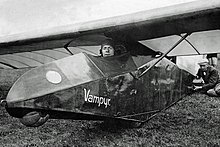HAWA Vampire
| Vampire | |
|---|---|

|
|
| Type: | Glider |
| Design country: | |
| Manufacturer: |
HAWA |
| First flight: |
1921 |
| Number of pieces: |
1 |
HAWA H 1 "Vampyr" was a German glider . It was designed by Arthur Martens , Friedrich Hentzen and Walter Blume - all of them former World War II pilots and at the time students of the Aviation Institute of the Technical University of Hanover - as part of the newly founded Akaflieg Hanover and built by the Hanoverian Waggonfabrik under the direction of Hermann Dorner . The design comes from Georg Madelung .
construction
The Vampyr is considered to be the ancestor of modern gliders, as it was the first to combine design features in an aircraft that shaped the design of performance gliders for decades. The lowest possible air resistance was the top priority when designing the aircraft. In contrast to the double-decker and boat designs still common at the time, the Vampyr had a closed hull. The wing was not braced except for two small auxiliary struts. The first single-spar construction of the wing with plywood-clad torsion nose (see Bredt's formula ) and ailerons as control surfaces, which was also adopted for powered aircraft, was groundbreaking .
use


In 1921 he first took part in the II Rhön competition on the Wasserkuppe. Arthur Martens covered 3580 meters in 5 minutes and 33 seconds in one flight. On September 5, he achieved a record flight of 7.5 km in 15 minutes and 40 seconds. In total, the Hanoverian prize money totaled 21,000 Reichsmarks.
A year later, the Vampyr was used in the same competition with a modified structure and set three new world records on August 18, 1922 with one hour and 6 minutes flight time, 8.9 km flight distance and 108 m cant, thus making the transition from gliding to Gliding. One day later, Friedrich Hentzen increased the flight time with the Vampyr to 2 hours 10 minutes, on August 21st even to 3 hours 6 minutes at 350 m cant.
A further development refined by Arthur Martens was the Strolch , which he flown at the IV Rhön Competition in 1923.
Whereabouts
The vampire was badly damaged in World War II and was in the basement of the Deutsches Museum in Munich. Cordes, a former director of Drägerwerke, took the initiative to restore the aircraft. The fuselage was restored in the Deutsches Museum, the wing, of which only the spar and fittings and fragments of the ribs remained, in the regional association workshop of the DAeC SH in Rendsburg- Schachtholm. The wing was returned to the Deutsches Museum in 1966 on the occasion of the German Aviation Day.
Technical specifications
| Parameter | Data |
|---|---|
| crew | 1 |
| length | 5.54 m |
| span | 12.6 m |
| Wing area | 16.0 m² |
| Wing extension | 10.8 |
| Wing loading | 13.1 kg / m² |
| Wing profile | Gö 482 |
| Glide ratio | 16 |
| Slightest sinking | 0.77 m / s |
| payload | approx. 80 kg |
| Empty mass | approx. 130 kg |
| Takeoff mass | 210 kg |
See also
literature
- Wolf Hirth (Hrsg.): Handbuch des Segelfliegens . 7th edition. Franckh'sche Verlagsbuchhandlung, Stuttgart 1957.
- Peter F. Selinger: Glider Stories. The gliders and gliders of the German Glider Museum with model flight on the Wasserkuppe . Stiftung Deutsches Segelflugmuseum Wasserkuppe with model flight, Gersfeld / Rhön 2004, ISBN 3-00-011649-4 .
Web links
- Vampire "Hanover". German Glider Museum Foundation with model flight, archived from the original on March 3, 2016 ; accessed on April 18, 2019 .
- Akaflieg Hannover Vampyr in the Deutsches Museum
Individual evidence
- ^ Frank-Dieter Lemke, Rolf Jacob: The academic flying groups in Germany until 1945. Part 2, in: Flieger Revue Extra No. 32, 2011, p. 60.
- ↑ a b Dietmar Geistmann: The gliders and motor gliders in Germany . 1st edition. Motorbuch Verlag, Stuttgart 2007, ISBN 978-3-613-02739-8 , pp. 20 .
- ^ Günter Brinkmann, Hans Zacher: The evolution of the gliders . 1st edition. Bernard & Graefe, Bonn 1992, ISBN 978-3-7637-6104-3 , pp. 32 .




